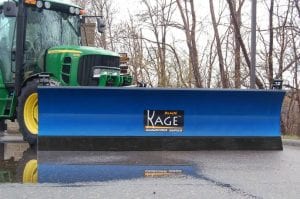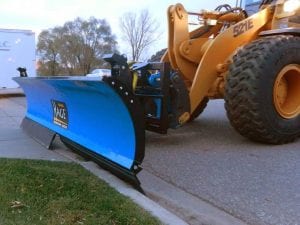Steel Edge Snow Pusher – When Should I Use Poly
A steel cutting edge will outperform all types of rubber, poly or plastic when it comes to scraping up snow from a parking lot or other paved surface. The KAGE snow plow box features a trip edge that allows you to bolt any type of cutting edge to it, and 5/8” thick, High Carbon 1084 steel is standard on our blades. Steel cutting edges provide the most cost effective way to remove snow and ice from pavement. Along with the standard steel edge for the KAGE plow & pusher, there is a polyurethane cutting edge option for those delicate paver, parking – ramp expansion joints, or driveway sealcoat applications.
 1084 High Carbon Steel Edge – The Standard In The Snow Plow Industry
1084 High Carbon Steel Edge – The Standard In The Snow Plow Industry
Most general purpose snow plow cutting edges are made from a steel compound called High Carbon 1084 steel. This steel is the economic choice as it is made through a cost effective hot rolled process, and outlasts many other steels when compared to it in a wear test. Other steels, such as AR400, Hardox, etc. may wear slightly better, but are very cost prohibitive. Other methods of manufacturing such as the use of carbide inserts, or heat treating, and extend the life of the steel cutting edge even further. Bottom line is that nothing will scrape a parking lot cleaner than a snow plow or snow pusher that utilizes a steel cutting edge.
 Polyurethane Cutting Edge – The Better Option For Delicate Surfaces
Polyurethane Cutting Edge – The Better Option For Delicate Surfaces
Polyurethane cutting edges are not to be mistaken for rubber or HDPE (High Density Polyethylene) plastic pusher cutting edges. These cutting edges are all very different, and there is only one clear choice when it comes to scraping a lot clear without damage.
Polyurethane Cutting Edge VS. Rubber Snow Plow Cutting Edges
You see a lot of rubber cutting edges on the snow pushers today. Rubber belting is sold in rolls 100+ feet in length, so it is very inexpensive. Rubber can be easily drilled, cut, and mounted to virtually any snow plow our snow pusher out there, as long as it is supported well enough to withstand the weight of the plow. Polyurethane, on the other hand, is poured and molded to a specific length from the factory, and is a little tougher to cut and fit to a custom application. Most of the time you will want to find a pre-molded edge to fit your specific application. This also makes the edge and material a little more expensive than the rubber. That is why rubber is the more common solution found on most snow pushers out there. However, when you compare the scraping characteristics, durability and longevity, you will see that polyurethane is usually the better choice overall. Check out what other snow plow professionals have to say here: https://www.plowsite.com/threads/steel-edge-on-a-pusher.54040/
Polyurethane Snow Plow Cutting Edge VS. HDPE, UHMWPE, Plastic Cutting Edges
 Many people have asked me what I think of the polyurethane cutting edges that are hard, white, and “you know, the cutting board material”. Well, what they are referring to is actually a hard plastic that is nothing like the polyurethane snow plow edge that KAGE supplies. The polyurethane that we supply is softer and more pliable than those plastics. The polyurethane material that we use for our cutting edges is a blend of several resins, poured into a mold. The other plastic is produced in larger sheets, and then cut down to size. The KAGE polyurethane cutting edge is a semi-flexible material that is somewhere between rubber, and a hard white cutting-board plastic. Since the polyurethane is somewhat flexible, and is self-lubricating, it has much greater resistance from tearing, cracking, and wear. In my experience it also outlasts those other hard plastics 50:1. I have actually burned up a 1” thick x 8” tall UHMW cutting edge in less than 2 hours!
Many people have asked me what I think of the polyurethane cutting edges that are hard, white, and “you know, the cutting board material”. Well, what they are referring to is actually a hard plastic that is nothing like the polyurethane snow plow edge that KAGE supplies. The polyurethane that we supply is softer and more pliable than those plastics. The polyurethane material that we use for our cutting edges is a blend of several resins, poured into a mold. The other plastic is produced in larger sheets, and then cut down to size. The KAGE polyurethane cutting edge is a semi-flexible material that is somewhere between rubber, and a hard white cutting-board plastic. Since the polyurethane is somewhat flexible, and is self-lubricating, it has much greater resistance from tearing, cracking, and wear. In my experience it also outlasts those other hard plastics 50:1. I have actually burned up a 1” thick x 8” tall UHMW cutting edge in less than 2 hours!
Steel Cutting Edge, Polyurethane, Plastic, or Rubber – Which One Should I Use?
For most applications, a 5/8” thick 1084 steel cutting edge will be a great place to start if your snow plow or pusher has some sort of trip mechanism. If extra longevity is required, then consider a heat treated or carbide insert option. This will give you the most square feet of asphault plowed per dollar spent. If you require a non marring solution that will scrape almost as well as steel, illiminate curb damage and damage to parking decks, then the clear choice is Polyurethane. Polyurethane will outlast the other ‘cutting board’ plastics, and scrape much better than rubber.

Recent Comments